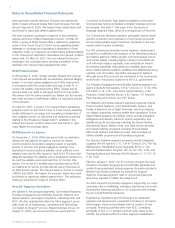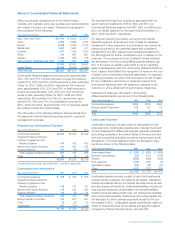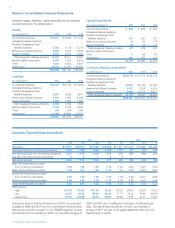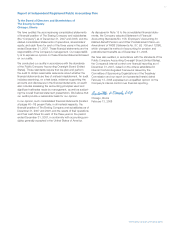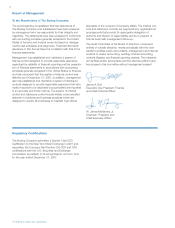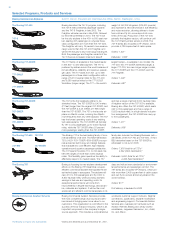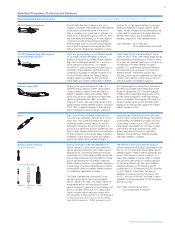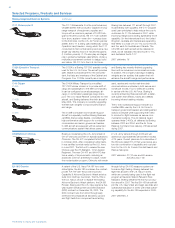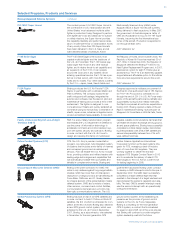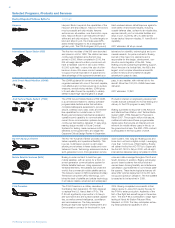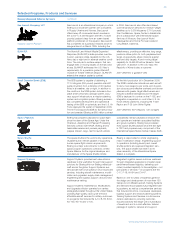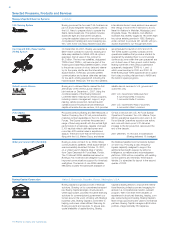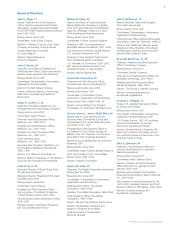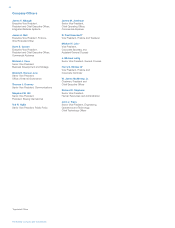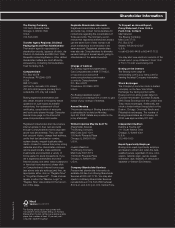Boeing 2007 Annual Report Download - page 86
Download and view the complete annual report
Please find page 86 of the 2007 Boeing annual report below. You can navigate through the pages in the report by either clicking on the pages listed below, or by using the keyword search tool below to find specific information within the annual report.
83
Selected Programs, Products and Services
Boeing Integrated Defense Systems continued
F/A-18E/F Super Hornet The combat-proven F/A-18E/F Super Hornet is
the cornerstone of U.S. naval aviation and the
United States’ most advanced multirole strike
fighter in production today. Designed to perform
both fighter (air-to-air) and attack (air-to-surface
or strike) missions, the Super Hornet provides
the capability, flexibility and performance neces-
sary to modernize the air or naval aviation forces
of any country. More than 335 Super Hornets
have been delivered to the U.S. Navy, and all
were delivered ahead of schedule. Active
F-15E Strike Eagle The F-15E Strike Eagle is the world’s most
capable multirole fighter and the backbone of
the U.S. Air Force fleet. The F-15E carries pay-
loads larger than those of any other tactical
fighter, and it retains the air-to-air capability and
air superiority of the F-15C. It can operate
around the clock and in any weather. Since
entering operational service, the F-15 has a per-
fect air combat record, with more than 100 vic-
tories and no losses. Four other nations currently
fly the F-15—Japan, Israel, Saudi Arabia and
F-22A Raptor Boeing produces the U.S. Air Force’s F-22A
Raptor in partnership with Lockheed Martin and
Pratt & Whitney. The company builds the air-
craft’s wings and aft fuselage, integrates the
avionics and software, has the lead on pilot and
maintenance training and provides a third of the
sustainment. The fighter is designed to over-
come all known threats and quickly establish air
dominance using its revolutionary combination of
stealth, super-cruise, advanced integrated avion-
ics and unmatched maneuverability. In mid-2007,
Family of Advanced Beyond-Line-of-Sight FAB-T is a key military transformation program
Terminals (FAB-T) that enables the U.S. Department of Defense to
use the power of information technology to
accelerate command-and-control decision sup-
port with speed, security and precision. Boeing
is under contract with the U.S. Air Force to
design and develop this family of multimission
Future Combat Systems (FCS) FCS, the U.S. Army’s premier modernization
program, is a networked, fully integrated system-
of-systems that includes a new family of manned
and unmanned ground and air vehicles and
sensors. FCS will enable the U.S. Army modular
force, providing soldiers and military leaders with
leading-edge technologies and capabilities that
will dramatically increase their survivability and
lethality in complex environments. Boeing and
Ground-based Midcourse Defense (GMD) Boeing is the prime contractor for GMD, the
nation’s only defense against long-range ballistic
missiles. GMD has more than 20 interceptors
deployed in underground silos at Vandenberg Air
Force Base, California, and Ft. Greely, Alaska.
An integral element of the global ballistic missile
defense system, GMD also consists of radars,
other sensors, command-and-control facilities,
communications terminals and a 20,000-mile
fiber-optic communications network. The U.S.
Global Positioning System (GPS) Boeing has built a total of 40 GPS satellites and
is under contract to build 12 follow-on Block IIF
satellites, the first of which is scheduled for com-
pletion at the end of 2008. Boeing also delivered
a new GPS ground control system, which was
activated by the U.S. Air Force in September
2007. Boeing, as a subcontractor, was selected
in November for the next-generation GPS
Electronically Scanned Array (AESA) radar
equipped Block II Super Hornets are currently
being delivered to fleet squadrons. In May 2007,
the government of Australia signed a Letter of
Offer and Acceptance to buy 24 F/A-18F Super
Hornets, becoming the first international cus-
tomer of the aircraft. Production is expected to
run through at least 2013.
2007 deliveries: 42
the Republic of Korea. Since October 2005, the
Republic of Korea Air Force has received 30 of
40 F-15Ks. In December 2005, the Republic of
Singapore selected the Boeing F-15SG for its
Next Fighter Replacement Program and, in 2007,
exercised an option for eight F-15SGs plus an
additional four. The F-15 is an extremely capable,
supportable and affordable option to fill multirole
force structure requirements around the world.
2007 deliveries: 12
Congress approved a multiyear procurement of
the final 60 of an authorized total of 183 Raptors
for FY07– 09. Production is scheduled to run
through the end of 2011. In U.S. Air Force evalu-
ations of the aircraft’s performance, lethality and
supportability during its first military exercises,
the Raptor surpassed all customer expectations.
During 2007, Boeing opened a state-of-the-art
Raptor maintenance-training “schoolhouse” at
Sheppard Air Force Base in Wichita Falls, Texas.
capable, satellite communications terminals that
will enable information exchange among ground,
air and space platforms. Boeing has successfully
completed a critical design review, demonstrat-
ing interoperability with a MILSTAR satellite and
secure interoperability between two of its soft-
ware-defined terminals.
partner Science Applications International
Corporation function as the lead systems inte-
grator for FCS, managing a best-of-industry
team of more than 550 suppliers. They are
working together to deliver the first fully-
equipped FCS Brigade Combat Team in 2015
and to accelerate the delivery of select FCS
technologies to the U.S. Army’s current force
for testing beginning in 2008.
government has placed Boeing under contract
to develop a GMD interceptor site for Europe. In
September 2007, the GMD team successfully
completed a missile defense flight test that
resulted in the intercept of a target warhead and
demonstrated the system’s capability and relia-
bility. The test, GMD’s seventh intercept overall,
was the second intercept with an operationally
configured interceptor.
ground control system, firmly establishing its
presence as the provider of ground control
systems to the U.S. Air Force. Separately,
Boeing is competing for the next-generation
GPS III system, a contract that is scheduled
for award in April 2008. All of this work ensures
that Boeing will continue to provide navigation
system leadership well into the future.
The Boeing Company and Subsidiaries



